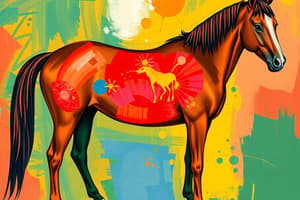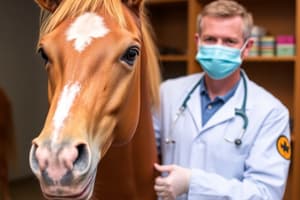Podcast
Questions and Answers
In equine hepatic disease, what is the significance of an increase in direct bilirubin exceeding 30% of the total bilirubin?
In equine hepatic disease, what is the significance of an increase in direct bilirubin exceeding 30% of the total bilirubin?
- It confirms acute liver failure rather than a chronic condition.
- It indicates a typical response to anorexia, leading to increased bilirubin production.
- It primarily signifies post-hepatic disease, suggesting an obstruction or issue beyond the liver itself. (correct)
- It specifically points to hemolysis as the primary cause of liver damage.
Why is photosensitization a clinical sign associated with hepatic disease in horses?
Why is photosensitization a clinical sign associated with hepatic disease in horses?
- Increased skin pigmentation causes the horse to be more susceptible to sunburn.
- The liver's inability to process certain vitamins leads to increased skin sensitivity to light.
- Hepatic disease causes an auto-immune response that targets skin cells, making them light-sensitive.
- Liver failure results in the accumulation of phylloerythrin, a photodynamic agent, in the skin. (correct)
What is the underlying mechanism by which hepatic encephalopathy develops in horses with liver disease?
What is the underlying mechanism by which hepatic encephalopathy develops in horses with liver disease?
- The liver's inability to detoxify substances like ammonia leads to neurotoxic effects. (correct)
- The accumulation of bilirubin leads to neurotoxicity and altered mental status.
- Increased intracranial pressure due to liver swelling causes neurological dysfunction.
- Encephalopathy is caused by the generation of auto-antibodies that target brain tissue.
In managing liver disease in horses, why are small, frequent feedings with easily digested carbohydrates recommended?
In managing liver disease in horses, why are small, frequent feedings with easily digested carbohydrates recommended?
What is the rationale behind using mineral oil and neomycin/lactulose in the treatment of hepatic encephalopathy?
What is the rationale behind using mineral oil and neomycin/lactulose in the treatment of hepatic encephalopathy?
In equine hyperlipemia, what distinguishes hyperlipemia from hypertriglyceridemia in terms of clinical significance?
In equine hyperlipemia, what distinguishes hyperlipemia from hypertriglyceridemia in terms of clinical significance?
What is the primary mechanism that leads to hyperlipemia in susceptible equines?
What is the primary mechanism that leads to hyperlipemia in susceptible equines?
What is the primary aim of increasing caloric intake when treating equine hyperlipemia?
What is the primary aim of increasing caloric intake when treating equine hyperlipemia?
What is the rationale for considering terminating pregnancy in mares affected by hyperlipemia?
What is the rationale for considering terminating pregnancy in mares affected by hyperlipemia?
Why is insulin sometimes used in the treatment of equine hyperlipemia, and what is a critical consideration when administering it?
Why is insulin sometimes used in the treatment of equine hyperlipemia, and what is a critical consideration when administering it?
What is the most common cause of liver disease related to pyrrolizidine alkaloids in horses, and how long after ingestion do clinical signs typically appear?
What is the most common cause of liver disease related to pyrrolizidine alkaloids in horses, and how long after ingestion do clinical signs typically appear?
What is the primary diagnostic method used to confirm Tyzzer's disease in foals, and what specific finding is typically sought?
What is the primary diagnostic method used to confirm Tyzzer's disease in foals, and what specific finding is typically sought?
How does bacterial cholangiohepatitis typically arise in horses, and what underlying conditions can predispose a horse to this infection?
How does bacterial cholangiohepatitis typically arise in horses, and what underlying conditions can predispose a horse to this infection?
What is the MOST common infectious cause of acute hepatitis related to biological products in horses?
What is the MOST common infectious cause of acute hepatitis related to biological products in horses?
What laboratory findings are MOST consistent with cholelithiasis?
What laboratory findings are MOST consistent with cholelithiasis?
What is the MOST common clinical sign seen with chronic megalocytic hepatopathy and fibrosis?
What is the MOST common clinical sign seen with chronic megalocytic hepatopathy and fibrosis?
Which of the following treatments has recent evidence suggesting benefit instead of contraindication when treating cholelithiasis?
Which of the following treatments has recent evidence suggesting benefit instead of contraindication when treating cholelithiasis?
What is the MOST common clinical sign associated with hepatic disease?
What is the MOST common clinical sign associated with hepatic disease?
What percentage of direct bilirubin suggests post-hepatic disease?
What percentage of direct bilirubin suggests post-hepatic disease?
Which trigger would warrant suspicion of hyperlipemia in a mini/pony?
Which trigger would warrant suspicion of hyperlipemia in a mini/pony?
What treatment has been shown to have antagonistic effects on hormone sensitive lipase?
What treatment has been shown to have antagonistic effects on hormone sensitive lipase?
What is the name of the confirmatory diagnostic test that can be performed to diagnose Tyzzer's disease?
What is the name of the confirmatory diagnostic test that can be performed to diagnose Tyzzer's disease?
Which of the following clinical sign can be seen with hepatic encephalopathy?
Which of the following clinical sign can be seen with hepatic encephalopathy?
Which is the most common cause of chronic liver disease?
Which is the most common cause of chronic liver disease?
Which of the follow is a treatment for hepatic encelphalopathy?
Which of the follow is a treatment for hepatic encelphalopathy?
Which of the follow is a treatment consideration for liver disease?
Which of the follow is a treatment consideration for liver disease?
Which are some breed considerations for hyperlipemia?
Which are some breed considerations for hyperlipemia?
Which of the following is a clinical sign for hyperlipemia?
Which of the following is a clinical sign for hyperlipemia?
Which of the following is a good consideration for increasing caloric intake?
Which of the following is a good consideration for increasing caloric intake?
Tyzzer's disease affects foals between what age range?
Tyzzer's disease affects foals between what age range?
What antitoxin is MOST commonly associated with theiler's disease?
What antitoxin is MOST commonly associated with theiler's disease?
Which is a common treatment choice for bacterial cholangiohepatitis?
Which is a common treatment choice for bacterial cholangiohepatitis?
Which of the follow is a description of serve hypertriglyceridemia?
Which of the follow is a description of serve hypertriglyceridemia?
What is the underlying cause of hyperlipemia?
What is the underlying cause of hyperlipemia?
How do bacterial infections occur within the bile duct?
How do bacterial infections occur within the bile duct?
How many weeks after ingestion do we typically see of pyrrolizidine alkaloid ingestion?
How many weeks after ingestion do we typically see of pyrrolizidine alkaloid ingestion?
In a horse with suspected hepatic disease and elevated liver enzymes, which clinical sign, if present, would MOST strongly suggest progression towards hepatic failure rather than just hepatic disease?
In a horse with suspected hepatic disease and elevated liver enzymes, which clinical sign, if present, would MOST strongly suggest progression towards hepatic failure rather than just hepatic disease?
A horse exhibits clinical signs consistent with hepatic encephalopathy. If diagnostic tests confirm liver disease, which of the following pathophysiological mechanisms is considered the MOST significant contributor to the neurological signs?
A horse exhibits clinical signs consistent with hepatic encephalopathy. If diagnostic tests confirm liver disease, which of the following pathophysiological mechanisms is considered the MOST significant contributor to the neurological signs?
What is the rationale for dietary protein restriction in horses with hepatic encephalopathy?
What is the rationale for dietary protein restriction in horses with hepatic encephalopathy?
Why is mineral oil administered via nasogastric tube in a horse exhibiting signs of hepatic encephalopathy?
Why is mineral oil administered via nasogastric tube in a horse exhibiting signs of hepatic encephalopathy?
In differentiating between hyperlipemia and severe hypertriglyceridemia in horses, which of the following clinical findings is MOST indicative of hyperlipemia?
In differentiating between hyperlipemia and severe hypertriglyceridemia in horses, which of the following clinical findings is MOST indicative of hyperlipemia?
What best describes the pathophysiology behind the development of hyperlipemia in a susceptible equine?
What best describes the pathophysiology behind the development of hyperlipemia in a susceptible equine?
Which is the primary goal when increasing caloric intake in a horse with hyperlipemia?
Which is the primary goal when increasing caloric intake in a horse with hyperlipemia?
In what scenario is terminating a mare's pregnancy a consideration in managing equine hyperlipemia?
In what scenario is terminating a mare's pregnancy a consideration in managing equine hyperlipemia?
When administering insulin to treat equine hyperlipemia, why is concurrent dextrose administration critical?
When administering insulin to treat equine hyperlipemia, why is concurrent dextrose administration critical?
What is the MOST significant factor determining the prognosis of pyrrolizidine alkaloid toxicity in horses?
What is the MOST significant factor determining the prognosis of pyrrolizidine alkaloid toxicity in horses?
Regarding Tyzzer's disease in foals, which of the following statements accurately reflects the diagnostic challenges associated with confirming the infection ante-mortem?
Regarding Tyzzer's disease in foals, which of the following statements accurately reflects the diagnostic challenges associated with confirming the infection ante-mortem?
In horses, how does bacterial cholangiohepatitis typically develop, and what underlying condition significantly elevates the risk of its occurrence?
In horses, how does bacterial cholangiohepatitis typically develop, and what underlying condition significantly elevates the risk of its occurrence?
In a horse with suspected cholelithiasis, what specific bloodwork abnormalities, in addition to elevated liver enzymes, would MOST strongly support this diagnosis?
In a horse with suspected cholelithiasis, what specific bloodwork abnormalities, in addition to elevated liver enzymes, would MOST strongly support this diagnosis?
Which of the following accurately describes the impact of chronic megalocytic hepatopathy and fibrosis on liver function?
Which of the following accurately describes the impact of chronic megalocytic hepatopathy and fibrosis on liver function?
A horse is diagnosed with cholelithiasis. Recent evidence suggests a potential benefit from which of the following treatments that was previously considered contraindicated?
A horse is diagnosed with cholelithiasis. Recent evidence suggests a potential benefit from which of the following treatments that was previously considered contraindicated?
Flashcards
Hyperlipidemia/Hypertriglyceridemia
Hyperlipidemia/Hypertriglyceridemia
Increase in triglycerides without organ failure; common with systemic disease and negative energy balance.
Hyperlipemia
Hyperlipemia
Increased triglycerides (>500 mg/dl) with lipemic plasma, fat infiltration, and organ dysfunction (especially liver).
Severe Hypertriglyceridemia
Severe Hypertriglyceridemia
Normal sized horses with triglyceride concentrations > 500 mg/dl but plasma is not opaque and includes no fat infiltration into organs.
Hyperlipemia Signalment
Hyperlipemia Signalment
Signup and view all the flashcards
Hyperlipemia Treatment- Increase Caloric Intake
Hyperlipemia Treatment- Increase Caloric Intake
Signup and view all the flashcards
Parenteral Nutrition for Caloric Intake
Parenteral Nutrition for Caloric Intake
Signup and view all the flashcards
Rx aims for Negative Energy Balance
Rx aims for Negative Energy Balance
Signup and view all the flashcards
Decrease Fat Mobilization
Decrease Fat Mobilization
Signup and view all the flashcards
Theiler's Disease
Theiler's Disease
Signup and view all the flashcards
Tyzzer's Disease
Tyzzer's Disease
Signup and view all the flashcards
Bacterial Cholangiohepatitis
Bacterial Cholangiohepatitis
Signup and view all the flashcards
Treating Bacterial Cholangiohepatitis
Treating Bacterial Cholangiohepatitis
Signup and view all the flashcards
Hepatotoxins
Hepatotoxins
Signup and view all the flashcards
Pyrrolizidine alkaloid
Pyrrolizidine alkaloid
Signup and view all the flashcards
Cholelithiasis signs
Cholelithiasis signs
Signup and view all the flashcards
Treating Cholelithiasis
Treating Cholelithiasis
Signup and view all the flashcards
Ursodiol/Ursodeoxycholic Acid
Ursodiol/Ursodeoxycholic Acid
Signup and view all the flashcards
Hyperbilirubinemia (Anorexia vs. Hemolysis)
Hyperbilirubinemia (Anorexia vs. Hemolysis)
Signup and view all the flashcards
Liver Disease (Common)
Liver Disease (Common)
Signup and view all the flashcards
Hepatic Encephalopathy
Hepatic Encephalopathy
Signup and view all the flashcards
Hepatic Encephalopathy Progression
Hepatic Encephalopathy Progression
Signup and view all the flashcards
Treat Liver disease with
Treat Liver disease with
Signup and view all the flashcards
Fluid Therapy
Fluid Therapy
Signup and view all the flashcards
Anti-inflammatory Drugs
Anti-inflammatory Drugs
Signup and view all the flashcards
Liver Treatment
Liver Treatment
Signup and view all the flashcards
Study Notes
- Equine Liver Disease is a complex condition requiring careful consideration.
Hepatic Disease
- The liver is highly regenerative.
- Hepatic disease may be present without clinical signs.
- It is possible to have hepatic disease with clinical signs, but without liver failure.
- Hepatic failure is the most severe form of liver disease.
Clinical Signs of Hepatic Disease
- Initially, clinical signs are non-specific, including anorexia, depression, fever, colic, and weight loss.
- Later signs may include icterus or jaundice, indicated by hyperbilirubinemia.
- There are 3 reasons for hyperbilirubinemia: anorexia, hemolysis, and liver disease.
- Anorexia and hemolysis cause an increase in unconjugated or indirect bilirubin.
- Liver disease causes an increase in just unconjugated bilirubin.
- Post-hepatic disease is indicated by an increase in both, with direct bilirubin > 30% of total.
- Hepatic disease clinical signs also include photosensitization, which is a sign of liver failure and related to phylloerythrin.
- Further clinical signs can include hepatic encephalopathy, depression, head pressing, aimless walking, and yawning.
- Progression of hepatic encephalopathy may involve aggressive behavior, stupor, recumbency, unconsciousness, seizures (not always), and coma.
Treatment of Liver Disease
- Treatment is generally supportive.
- Specific treatments include antibiotics for bacterial cholangiohepatitis.
- Antibiotics are often used as a differential diagnosis.
- Fluid therapy is not needed for mild disease, but is often needed for moderate/severe cases, especially in the presence of hepatic encephalopathy.
- It is important to monitor electrolyte and acid-base balances, and watch for hypoglycemia.
- Anti-inflammatory drugs can be included in treatment.
- NSAIDs, DMSO, Pentoxifylline and Steroids are all options, with associated pros and cons.
- Nutritional support is important, with small frequent feedings of easily digested carbohydrates and a low protein diet.
- The goal is to lower glycogen stores, prevent lipolysis and subsequent hyperlipemia.
- Drugs such as Pentoxifylline and Colchicine may be used to inhibit fibrosis.
- Treatment for hepatic encephalopathy aims to reduce ammonia/toxin formation in the gastrointestinal tract.
- Mineral oil and Neomycin/Lactulose may be used, but diarrhea is a concern.
Equine Hyperlipemia/Hypertriglyceridemia
- Hyperlipidemia/Hypertriglyceridemia is defined by an increase in triglycerides (TG).
- A horse is not lipemic if TG < 500 mg/dl.
- There is also no organ failure
- It is common in all horses with systemic disease and negative energy balance.
- Hyperlipemia is defined as increased TG, > 500 mg/dl and opaque plasma.
- It is also associated with fat infiltration and organ dysfunction, especially in the liver.
- Severe hypertriglyceridemia can occur in normal-sized horses with triglyceride concentrations > 500 mg/dl, but the plasma is not opaque and there is no fat infiltration into the liver/kidney.
- Hyperlipemia is more common in minis, ponies, and donkeys, and affects females more often (pregnant, lactation), and is usually associated with overweight animals.
- Clinical signs include non-specific signs of anorexia and weakness.
- Signs of hepatic lipidosis include colic, hepatic encephalopathy, abortion, and renal failure.
- Hormone-sensitive lipase breaks down TG into FFA & glycerol.
- The body either uses oxidation for energy Acetyl CoA or ketones (poor to little).
- TG becomes VLDL, then lipoprotein lipase then FFA for peripheral tissues to use for energy.
- In hyperlipemia, there is an increase in release of VLDL, faster than peripheral tissues can use.
- Excess accumulation of TG in liver, not due to reduced ability to clear VLDL.
- Lipoprotein lipase at maximal activity.
- Overproduction of TG & VLDL.
- Hyperlipemia should be suspected in any mini/pony that is off feed.
- Measure triglycerides.
Hyperlipemia Treatment Aims
- Increase caloric intake by offering palatable feeds like green grass, alfalfa, and grain.
- Assisted Enteral Feeding via Water Soaked Pellets-large NG tube
- Commercial Formulas
- Intravenous or Parenteral Nutrition can also assist with increased caloric intake.
- Partial nutrition involves 5% Dextrose with IV fluids.
- Complete nutrition involves Concentrated dextrose and AA, but is more complicated.
- The main goal is to reverse negative energy balance, which may involve weaning early.
- Consider terminating pregnancy and identify & treat the underlying disease.
- Decrease Fat Mobilization, by using Insulin, as it has antagonistic effects on hormone sensitive lipase.
- Use insulin with dextrose, but monitor for hypoglycemia.
- Increase TG uptake into peripheral tissues by administering Heparin, as it will increase lipoprotein lipase, but activity is already increased.
Theiler's Disease
- Theiler's Disease is characterized by acute hepatic necrosis, serum-associated hepatitis, and serum sickness.
- Biological products such as tetanus antitoxin most common is know to cause liver necrosis.
- Takes weeks to months to develop
- Any antitoxin, plasma products, modified live vaccines can also have this response
- A 2018 publication linked Equine parvovirus-hepatitis, resulting in contamination of these products.
- The virus can also be found in normal horses and has evidence of horizontal transmission.
Tyzzer's Disease
- It is caused by Clostridium piliformis.
- Affects foals aged 7-42 days.
- Suspect this disease with foals with liver disease.
- Diagnosis is confirmed through histopathology, silver stain, PCR ans Culture, however is difficult to grow.
- The source is unknown Feces of healthy horses , possibly the Mare’s.
- Foals ingest feces via Corpophagia (normal).
- Rx- penicillin (and others)
- The Prognosis is poor.
Bacterial Infections
- Bacterial cholangiohepatitis is the most common bacterial infection of the liver.
- In most cases it is an ascending infection of bile duct that is 2ndary to other diseases like Enteritis and Cholelithasis.
- Primary hepatitis is uncommon.
- Diagnosed via Liver Biopsy, Culture & Histopath.
- Treatment includes antibiotics based on bacterial sensitivity.
- Common first use antibiotics include SMZ-TMP and Enrofloxaxin/B-lactam.
Hepatotoxins
- Diagnosis depends biopsy/histopath .
- Chronic Megalocytic Hepatopathy occurs, resulting in fibrosis and cells cant divide.
- Diagnosis can be made via histology.
- Pyrrolizidine alkaloid is the most common cause of chronic liver disease.
- Results from chronic low-level ingestion.
- Clinical signs present 4-12 weeks post ingestion.
- Liver disease & failure (HE) and Poor prognosis.
Cholelithiasis
- Cholelithiasis presents clinically as fever, colic and Icterus.
- Bloodwork results: Bile Acids show Marked increase
- Albumin and BUN is normal
- Direct Bilirubin will be > 30% of total.
- Treatment is long term medical management.
- Antibiotics, NSAID, DMSO are options.
- Surgery reported- difficult
- Prognosis depends on size & number of choleliths.
- Ursodiol or Ursodeoxycholic Acid is Naturally occurring bile salt that’s used to dissolve cholesterol stones
- Was previously contraindicated in horses, but Recent work shows this can actually be helpful
Studying That Suits You
Use AI to generate personalized quizzes and flashcards to suit your learning preferences.




